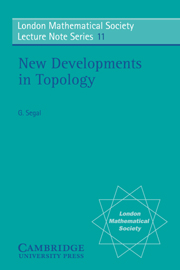Book contents
- Frontmatter
- Contents
- Preface
- 1 Operations of the nth kind in K-theory, and what we don't know about RP∞
- 2 The Pontrjagin dual of a spectrum
- 3 Algebraic K-theory of non-additive functors of finite degree
- 4 Dyer-Lashof operations in K-theory
- 5 Homotopy homomorphisms of Lie groups
- 6 On spherical fiber bundles and their PL reductions
- 7 E∞ spaces, group completions, and permutative categories
- 8 Higher K-theory for categories with exact sequences
- 9 Operations in stable homotopy theory
- 10 Equivariant algebraic K-theory
- 11 On rank 2 mod odd H-spaces
1 - Operations of the nth kind in K-theory, and what we don't know about RP∞
Published online by Cambridge University Press: 05 April 2013
- Frontmatter
- Contents
- Preface
- 1 Operations of the nth kind in K-theory, and what we don't know about RP∞
- 2 The Pontrjagin dual of a spectrum
- 3 Algebraic K-theory of non-additive functors of finite degree
- 4 Dyer-Lashof operations in K-theory
- 5 Homotopy homomorphisms of Lie groups
- 6 On spherical fiber bundles and their PL reductions
- 7 E∞ spaces, group completions, and permutative categories
- 8 Higher K-theory for categories with exact sequences
- 9 Operations in stable homotopy theory
- 10 Equivariant algebraic K-theory
- 11 On rank 2 mod odd H-spaces
Summary
Operations of the nth kind in K-theory
In the old days, if you wanted to solve some concrete problem in homotopy theory, you began by calculating the ordinaty cohomology groups of all the spaces involved. Then you used primary cohomology operations, such as cup-products and the Steenrod operations. If, or when, those didn't yield enough information you tried secondary ones, and then tertiary and higher ones. Of course, if the problem needed tertiary operations you didn't publish the argument in that form because it was too nasty. However, it was sometimes possible to avoid some of the nastiness by using suitable formal machinery like the Adams spectral sequence.
A little later we realised, with great pleasure, that sometimes by using a generalised cohomology theory – perhaps with primary operations – you could successfully tackle a geometrical problem which if done by ordinary cohomology would have needed operations of arbitrarily high kind. It was always conceded that the choice of the cohomology theory most useful for a particular problem might take hard work, or luck, or both. But there was a sort of democratic movement, which proclaimed that every generalised cohomology theory deserved equal rights. For example, Atiyah showed that it is technically possible to teach K-theory before ordinary cohomology. Of course all normal people still did their calculations in ordinary cohomology first, but they were made to feel that they were mere slaves of habit. The philosophy prevailed that all the apparatus of calculation, with which we are so familiar in the ordinary case, should be set up for generalised cohomology. It was conceded that some results like the Kunneth theorem might require restrictive hypotheses.
- Type
- Chapter
- Information
- New Developments in Topology , pp. 1 - 10Publisher: Cambridge University PressPrint publication year: 1974
- 11
- Cited by



